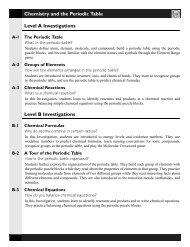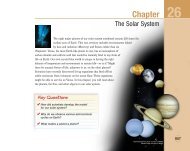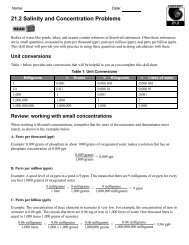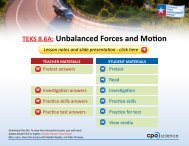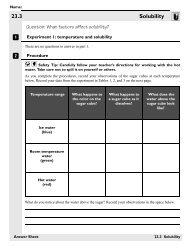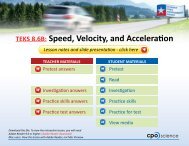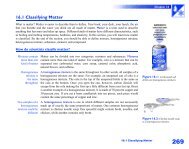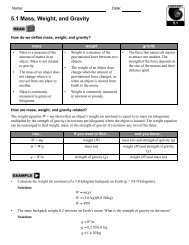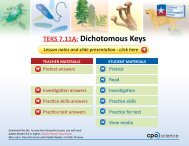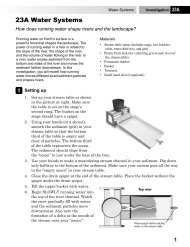FPS Investigations.book - Cambridge Physics Outlet
FPS Investigations.book - Cambridge Physics Outlet
FPS Investigations.book - Cambridge Physics Outlet
- No tags were found...
You also want an ePaper? Increase the reach of your titles
YUMPU automatically turns print PDFs into web optimized ePapers that Google loves.
FIRST EDITION<strong>Cambridge</strong> <strong>Physics</strong> <strong>Outlet</strong>Peabody, Massachusetts 01960
Table of ContentsUnit 1: Forces and Motion1.1 Time and Distance..................................21.2 <strong>Investigations</strong> and Experiments ...........61.3 Speed .........................................................82.1 Using a Scientific Model to Predict Speed102.2 Position and Time.................................122.3 Acceleration...........................................143.1 Force, Mass, and Acceleration...........163.2 Weight, Gravity, and Friction.............203.3 Equilibrium, Action, and Reaction.....22Unit 2: Work and Energy4.1 Forces in Machines ...............................244.2 The Lever................................................264.3 Designing Gear Machines....................285.1 Work .......................................................305.2 Energy Conservation............................345.3 Energy Transformations ......................38Unit 3: Electricity and Magnetism6.1 What Is a Circuit?.................................406.2 Charge .....................................................427.1 Voltage.....................................................447.2 Current ...................................................467.3 Resistance ...............................................488.1 Ohm’s Law .............................................508.2 Work, Energy, and Power ..................529.1 More Electric Circuits .........................569.2 Series Circuits........................................589.3 Parallel Circuits .....................................6010.1 Permanent Magnets..............................6210.2 Electromagnets......................................6610.3 Electric Motors and Generators .......68Unit 4: Sound and Waves11.1 Harmonic Motion................................. 7411.2 Graphs of Harmonic Motion............. 7811.3 Simple Mechanical Oscillators........... 8012.1 Waves..................................................... 8212.2 Waves in Motion.................................. 8412.3 Natural Frequency and Resonance.. 8613.1 Sound ...................................................... 9013.2 Properties of Sound............................. 9413.3 Music....................................................... 98Unit 5: Light and Optics14.1 Introduction to Light......................... 10014.2 Color..................................................... 10415.1 Seeing an Image .................................. 10615.2 The Human Eye.................................. 10815.3 Optical Technology ........................... 112Unit 6: Properties of Matter16.1 Classifying Matter............................... 11416.2 Measuring Matter............................... 11616.3 States of Matter.................................. 11817.1 Properties of Solids ........................... 12017.2 Density of Fluids................................. 12417.3 Buoyancy of Fluids ............................. 12617.4 Viscosity of Fluids............................... 12818.1 Atomic Structure ............................... 13018.2 Comparing Atoms ............................. 13218.3 The Periodic Table of Elements...... 136
Unit 7: Changes in Matter19.1 Bonding and Molecules .....................14019.2 Chemical Formulas ............................14219.3 Comparing Molecules .......................14420.1 Chemical Changes..............................14620.2 Chemical Equations ...........................14820.3 Conservation of Mass .......................15020.4 Using Equations ..................................15221.1 Classifying Reactions .........................15621.2 Energy in Reactions ...........................15822.1 Nuclear Reactions..............................16022.2 Carbon Reactions ..............................162Unit 9: Heating and Cooling26.1 Temperature Scales...........................18026.2 Measuring Changes in Heat .............18226.3 Specific Heat........................................18627.1 Conduction..........................................19027.2 Convection ..........................................19227.3 Radiation...............................................19428.1 Weather ...............................................19628.2 Living Systems .....................................19828.3 Mechanical Systems............................200Unit 8: Water and Solutions23.1 What is a Solution?............................16423.2 Dissolving Rate ...................................16623.3 Solubility...............................................16824.1 Water....................................................17224.2 The Water Cycle ...............................17425.1 Acids, Bases, and pH .........................17625.2 Acid Rain ..............................................178
Question: What is magnification and how do you plot a reflected image?In this Investigation, you will:1. Determine the magnification of a converging lens.2. Trace incident and reflected rays from a mirror using a laser.3. Learn how images are formed in optical systems.UNIT 5: Light and Optics15.1 Seeing an ImageWe see images that are formed by the eye from light that comes from objects. Because light can bebent by lenses or mirrors, the image we see can be different from the object that produced it. With amagnifying lens, we can make an image seem larger than the object. The magnification is the ratio ofimage size to actual object size. In this Investigation, you will learn a shortcut method for finding themagnification of a single lens. Another way an image can be different from the object is in itsorientation and location. For example, the image you see reflected in a mirror is reversed left-to-rightand appears to be behind the mirror. In part 2 of this Investigation, you will learn how to predict wherethe image in a mirror appears by tracing the incident and reflected rays of light from a laser.AFinding the magnification of a lens1. Set your lens directly on the graph paper and count the number ofunmagnified squares that cross the diameter of the lens. In theexample, the lens is 10 squares wide.2. Next, examine a section of graph paper with your lens held above thepaper. Move the lens closer and farther away until you have thebiggest squares you can still see clearly in the lens.3. Count the number of magnified squares that cross the diameter of thelens. For example, the picture shows 4 1/2 squares across the lens.4. The magnification can be calculated by dividing the number ofunmagnified squares by the number of magnified squares. In theexample, you see 10 unmagnified squares and 4.5 magnified squares.The magnification is 10 ÷ 4.5, or 2.22.5. Try the experiment again using a ruler to measure the distancebetween the lens and the paper. Notice that the magnification changeswith different distances.6. Fill in the table by measuring the magnification of your lens for atleast four different distances. The number of squares on the graphpaper will be the same for all distances.Distanceto paperTable 1: Magnification of a lens# of squares on graph paper # of squares in lens(unmagnified squares) (magnified squares)Magnification106
15.1 Seeing an Image UNIT 5: Light and OpticsBReflections in a mirror1. Secure a sheet of graph paper to the optics tablewith the magnetic strips.2. Draw a line on the paper to mark where you willplace a mirror. Place a mirror along this line.3. Draw a 1-centimeter-long arrow on the graphpaper about 3 centimeters away from your line.The arrow should be parallel to the line.4. Move your head until you can see the reflectionof the arrow in the mirror. The image of thearrow appears to be behind the mirror.5. Hold your pencil straight up with the point on the tip of your arrow. Use the pencil to set the laserbeam so it passes right over the tip of your arrow, and hits the mirror.6. Trace the laser beam using your pencil as a guide.Trace the beam before it hits the mirror and afterit hits the mirror.7. Move the laser so the beam passes over the tip ofyour arrow from a different angle, but still hits themirror. Trace the beam with your pencil like youdid in steps 5 and 6.8. The lines you drew represent rays of light beforeand after they hit the mirror. The incident ray shows the light before it hits the mirror. Thereflected ray shows the path of the light after it bounces off the mirror.9. Remove the mirror and use a ruler to extend the two reflected rays. They should meet in a point onthe other side of the line where the mirror was. This point is where you saw the image of the tip ofthe arrow. The image is where all rays that leave the same point on an object meet together again.Safety Tip: NEVER look directly into a laser beam. Some lasers can cause permanentdamage to your eyes.CThinking about what you observeda. Describe how the magnification changed as you changed the distance from the paper to the lens. Doesthe magnification get larger or smaller with distance?b. Could you adjust the distance between the paper and the lens to get any magnification you wanted, orwas there a point where the lens could no longer create a sharp image?c. Describe why the image formed by a mirror appears to come from the place where the reflected raysmeet. In your answer, refer to the fact that each point on an object is the source of many rays of light.You might want to include a sketch.d. Pick one pair of incident and reflected rays. Draw a straight line perpendicular tothe point where the rays hit the mirror. This perpendicular line is called thenormal in optics. Use a protractor to measure the angle between the incident rayand the normal, and between the reflected ray and the normal. From your angles,what can you say about the relationship between the direction of the incident rayand the direction of the reflected ray?107
The cover is an evocative montage of historical and scientific achievements thatdemonstrate the incredible persistence of the human intellect. Around the border,daVinci’s graphics reflect an evolving tapestry of conceptual thinking as they interweavewith more contemporary themes. DaVinci’s fantastical mechanisms become the modernbicycle, a quintessential machine, which rolls into a graphical interpretation ofwavelength division multiplexing on a fiber optic. The images follow 500 years ofscientific and technological innovation. The Earth and DNA symbolize theinterdependence of the built world and the natural world. The exquisite blend of formand function revealed in the elegant geometry of the chambered nautilus folds into aspiral defined by the Golden Rectangle. The interplay of organic and architectural formsrepresents the balance we seek between the power of technology and the fragility of ourlives and our world. I hope this colorful interplay of images will inspire interest andexcitement about the discovery of science.Bruce Holloway - Senior Creative DesignerFoundations of Physical Science - <strong>Investigations</strong>Copyright 2002 <strong>Cambridge</strong> <strong>Physics</strong> <strong>Outlet</strong>ISBN 1-58892-006-23 4 5 6 7 8 9 - QWE - 05 04 03All rights reserved. No part of this work may be reproduced or transmitted in any form or by anmeans, electronic or mechanical, including photocopying and recording, or by any informationstore or retrieval system, without permission in writing. For permission and other rights underthis copyright, please contact:<strong>Cambridge</strong> <strong>Physics</strong> <strong>Outlet</strong>26 Howley Street,Peabody, MA 01960(800) 932-5227http://www. cpo.comPrinted and Bound in the United States of America



